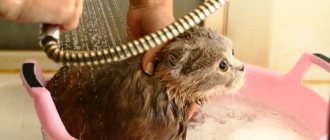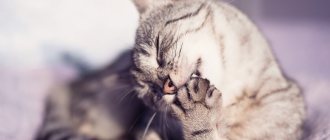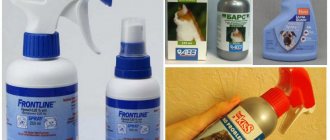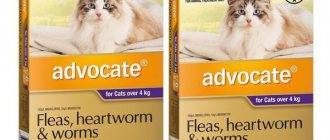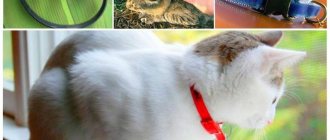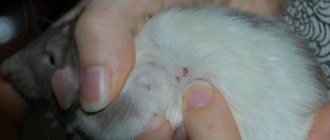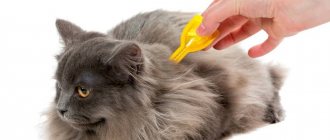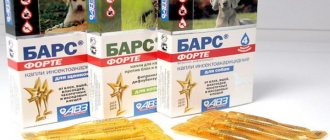Fleas are blood-sucking insects that feed on the blood of warm-blooded mammals. Common species: cat fleas (Ctenocephalides felis), human fleas (Pulex irritans), dog fleas (Ctenocephalides canis), rat fleas (Xenopsylla cheopis). These groups of parasites do not specialize in one host - the dog flea bites cats, the cat flea bites dogs, and the rat flea attacks people. Fleas are insects that undergo metamorphosis (complete transformation), including four stages of development - egg (7-14 days), larva (10-15 days), pupa (6-10 days), imago (3-18 months). Adult fleas jumping around the house and biting a dog or cat make up only 5-7% of the parasite population in the apartment, 35% are larvae, 10% are pupae, 50% are eggs. In addition, a flea does not live permanently on a pet’s body, so treatment against insects must be comprehensive: the use of drugs based on growth regulators to treat the animal + sanitary treatment of the premises.
There are many means to get rid of and prevent the appearance of parasites, the most effective of which are flea drops. They are used for the treatment and protection of sexually mature animals, kittens and puppies up to 3 months.
Types and composition of drops
Flea drops are a concentrated solution of insecticides, which are characterized by low toxicity and rapid action. The best option is drugs with juvenile effects that block the development mechanism of blood-sucking individuals at all stages:
- phenylpyrazoles (pyriprole, fipronil). The safest substances, since they preferentially inhibit GABA receptors of insects and not animals, which guarantees reliability for antiparasitic use. They work in a contact way, causing flea hyperactivity and their subsequent death;
- organophosphorus compounds (organophosphates, FOS). They are highly toxic, irritate the skin, irreversibly suppress (inhibit) enzymatic and physiological processes, accumulate in the animal’s body; with prolonged use, fleas develop resistance (resistance) to the drug and it stops working;
- pyrethroids. Safe for dogs/cats due to the absence of mutagenic and carcinogenic properties. Often cause skin reactions, do not penetrate into the blood;
- ivermectin. Affects the nervous system of fleas, prevents the maturation of eggs, pupae, larvae, and is moderately toxic. It is not recommended to treat sick, weakened animals or lactating bitches with preparations containing ivermectin;
- diflubenzuron. It inhibits the production of quinine, which protects the integument of eggs/larvae, has a weak effect on adults, and has low toxicity.
In addition to the basic insecticide, flea drops contain hormones that regulate stage-by-stage development (juvenile), synergists (enhancers) of the action of insectoacaricides, and additional substances that affect specific types of insects.
In what cases do veterinarians recommend using drip medications?
Drops against fleas, ticks and worms for cats are the most effective and safe means for getting rid of parasites and preventing their occurrence. Thanks to this form, they are quickly absorbed into the skin of furry pets and evenly distributed throughout the body. After consuming blood with an insecticide, fleas will die within 24 hours, and the protective effect after their use will last at least a month. In addition, the drops can be applied precisely to those places where the animal definitely cannot reach and lick the drug. Among the existing drops against fleas and ticks for cats, each owner will be able to choose an option that is acceptable for him and his pet - effective, cheap, safe.
Veterinarians do not recommend using drops against fleas and other external parasites for the following categories of pet cats:
- kittens under 2 months old;
- cats during pregnancy and lactation;
- sick, weakened and recovering pets.
Drops are the best flea remedy for cats that often walk outside, as well as for very active pets that cannot sit quietly for even a couple of minutes. Anti-flea preparations in this form are perfect for both long-haired and short-haired pets.
How do flea drops work?
After application, the drops migrate through the fatty layer of the animal’s skin, the active substance is distributed, without penetrating into the bloodstream, through this layer, quickly absorbed into the hair follicles and sebaceous glands, returning over time back to the upper layers of the epidermis.
Pros:
- treating an animal with drops is more reliable and simpler than treating with an emulsion/spray; an additional bonus is savings when treating large breed dogs;
- from the point of view of ease of treatment, drops are the most reliable means of protection;
- there is no problem with determining the dosage;
- the risk of the substance getting on the mucous membranes and licking is minimal;
- long-term effect on insects - the drug actively works for 1-2 months.
Minuses:
- the drops do not begin to act immediately, it takes 12-14 hours for them to “unfold”;
- the effectiveness of the substance may be reduced due to unpredictable factors - swimming, rain, sunlight, dirt;
- the drug may not “reach” the tail, ears, or paws of the animal;
- There are real risks of overdose, especially for cats/dogs whose weight does not exceed 2 kilograms.
Drops should be counted on as a priority treatment and protection for your pet. The safest insecticides are phenylpyrazoles and pyrethroids; more toxic substances in drops can be potentially dangerous.
What happens to fleas after treatment?
If the flea drops are based on a repellent, then after treatment the insects quickly leave the animal in order to be as far as possible from the unpleasant odor. If the drug is insecticidal, then it affects the nervous system of parasites, blocking receptors and disrupting the transmission of nerve impulses, as a result of which:
- fleas lose their ability to reproduce;
- insects cannot eat, breathe, move and die from paralysis.
Many drugs act not only on mature individuals, but also on larvae. The active substance penetrates into the egg, causing the death of the larva.
How to choose effective drops
Choosing an anti-flea agent is a serious matter, since not all drops are equally safe and effective. Before purchasing them, you should consult with your veterinarian so that he can help you calculate the dosage depending on the weight/age of your pet.
Instructions:
- Study the range of drops in a veterinary pharmacy, paying attention to the concentration and degree of toxicity of insecticides and additional substances. The effectiveness of the drug is determined on the basis of special tests, the result of which is the “flea control” index; it should be at least 80-90%; if the figure is lower, it is better not to buy drops.
- Make sure that the expiration date has not expired.
- Consider the age of the cat or dog: drops for puppies and kittens, weakened animals, lactating/pregnant bitches have a lower content of active ingredients.
- You should not treat cats with drops for dogs and vice versa - this can lead to intoxication of the animal.
- It is not recommended to use two or more types of drops at the same time - this is fraught with a weak antagonist, suppression of transport and synergy, and an abnormal increase in toxicity. Conditionally safe options: phenylpyrazoles + pyrethroids; if necessary, carbamates can be added to the mixture.
Rules for applying drops to a cat
In order for the composition to act as effectively as possible, it is important to follow the rules of application. The process itself is quite simple. It is necessary to secure the animal so that it does not twitch during the process. After this, the fur on the neck and between the shoulder blades is pulled apart. The composition drips onto the skin. Ideally, it is better to hold the animal in your hands for a while and calm it down. Next, the process lies in the details:
- If you plan to wash the animal before the effect of the composition expires, you need to stop using it before bathing or carry out the hygiene procedure earlier.
- If the cat has a very thick undercoat and it is very difficult to reach the skin, some owners trim an inconspicuous area of fur with the utmost care. This will make processing much easier.
- If the animal was bathed with flea shampoo or treated with another composition, then it is necessary to maintain the time between medications. The duration of the break depends on the specific form of insecticide.
- In addition to the animal, its bed, the place where it lives, and toys should be treated with flea products. Afterwards, objects and surfaces are thoroughly washed or washed.
- If additional exposure is required, you should consult a veterinarian, as too frequent use of insecticides can lead to poisoning of the cat.
- After applying the product, it is important to ensure that the animal does not shake itself off for some time and does not try to paw into the treatment area. The latter is dangerous in the context of licking.
- If it is not possible to prevent licking, then you should put protective material in the form of a blanket or collar on the cat.
The composition is considered safe immediately after drying. But in no case can you “adjust” the absorption process with the same hairdryer. It pays to be patient here.
Review of popular flea drops
- Advantix. A drug based on permethrin. It has a high dosage of pyrethroids (compared to the norm, it is exceeded by the manufacturer by 5-10 times), which can cause irritation of the skin of animals and an allergic reaction in cats. Protection in 50% of cases of use. It is recommended to use simultaneously with the Kiltix collar, propoxur or fipronil sprays.
- UltraGuard. The most reliable drops with pyrethroids, safe, do not cause irritation or allergies, optimally used with an UltraGuard collar.
- Leopard. A popular domestic product, it is available in two versions - based on permethrin and fipronil. Only 20% of penetration was detected. A good inexpensive drug, but there are two points: It is recommended to purchase Leopard only from trusted suppliers in order to avoid counterfeiting; the manufacturer sometimes makes mistakes in doses in batches, so it is better to reduce processing time; for large animals, increase the dose by one pipette. Works reliably in combination with Bars spray and Kiltix collar.
- Frontline. They “break through” in 40% of cases, combined with Bars/Bolfo sprays.
- Inspector. Intended for the treatment and prevention of flea infestation, used for damage by fleas, ticks, lice eaters. Contraindicated for puppies and kittens under 7 weeks of age.
Advantages over other insecticidal drugs
suppress the onset of fleas , ticks , and intestinal parasites in a variety of ways. But if you want to get rid of unwanted guests as soon as possible and for a long time, insecticidal drops will be the best remedy .
The popularity of such tools can be explained simply:
- All types of drops are produced in special dropper pipettes . Thus, calculating the dosage of the drug is significantly simplified;
- You can treat a cat captivated by fleas even without outside help;
- most drop manufacturers exclude the possibility of re-infection with parasites within several months after using the product.
Rules of application
Before applying the medicine, you must carefully examine the cat/dog's skin for rashes and wounds:
- drops are applied to the withers at one point, for greater effectiveness - along the ridge at several points, avoiding contact with the fur if possible. A small amount of the drug is applied under the neck, at the base of the skull, distributed over the back;
- The cat or dog should not be bathed 24 hours before and after treatment, so as not to damage the fatty layer of the skin. Compliance with this rule is mandatory; if ignored, treatment will have to be repeated;
- droplet protection weakens over time: the highest protection profile is observed in the first 7 days, after three weeks the containment indicator decreases by 10 points, after 4 - by 25-30 points.
How to use correctly
The principle of processing an animal is as simple as possible and is the same for all types of drops. The process should begin by determining the body weight of the tailed friend . After the weight is determined, you need to read the instructions for the product , finding out how much liquid to use in a particular case.
The last stage of the process is to directly apply the drops to the cat's skin.
The procedure for using the drug should be approached most carefully . All types of flea products are applied to areas of the body that are inaccessible to the animal for licking.
As a rule, such places are the withers and the spine area . After using the product, the cat should not be bathed. If the animal’s habitat is not limited to the apartment, then it is necessary to ensure that the animal does not get caught in the rain. Otherwise, the remedy will not work .
Why do drops work poorly or don’t help?
If after treating the animal it was not possible to get rid of fleas, there may be two reasons:
- non-compliance with dosage. The dosage must be observed as strictly as possible: exceeding it is fraught with poisoning, and an insufficient amount of the drug will not give the expected effect;
- violation of technology. You should not treat the animal's paws, or the animal's belly - only the withers, otherwise the animal will lick the substance, which can lead to intoxication and a sharp decrease in effectiveness.
Sometimes even expensive, proven drops do not work - this is explained by the fact that fleas develop resistance to a certain insecticide, in which case the drug should be replaced with another, which contains an insecticide of a different class.
Requirements for the product for skin application of spot-on against fleas
To choose the right drug for a kitten or adult animal, you need to consult a doctor. Spot-on facilities must meet the following requirements.
Efficiency.
The drops are really effective against most skin parasites. They help to quickly get rid of fleas without harming the animal.
Safety.
The “toxic” substances in the drugs only affect pests. They are practically safe for cats' health. But, like any medicine, spot-on drops have contraindications, so before using the product you should consult a specialist.
Versatility.
Spot-on products are suitable not only for the complete destruction of insects. The drug will prevent infection if you go with your pet to nature, becoming an excellent preventive measure. In addition, many products have a complex effect, also protecting against ticks, lice, lice, and some against intestinal parasites.
id=»u»>Can drops be used to treat a room?
No you can not. To treat the premises, special preparations containing a higher concentration of chemicals should be used. Due to their toxicity, during spraying it is necessary to use personal protective equipment (mask, gloves, goggles), and take household members and pets outside. If parasites have spread throughout the house, the algorithm of action should be as follows: treatment of the pet until complete recovery - sanitization of the premises - repeated sanitization.
Symptoms of the lesion
Pet owners often wonder: how to determine the presence of these parasites? If there are few fleas, then it is quite difficult to notice them in thick fur. The cat scratches itself from time to time, and does it suddenly, looking up from interesting things like playing and eating food. Your pet's behavior changes as the number of fleas increases. Characteristic traces of the presence of insects appear on the cat’s body: local wounds and sores, black “crumbs” of flea excrement, as well as scratch marks from claws and teeth. In an effort to get rid of parasites, pets can bite into their own skin. The uncomfortable state due to constant severe itching deprives the cat of its usual rest and causes a change in behavior. She may become lethargic and drowsy or, conversely, overly active.
Overdose
Poisoning of dogs and cats with flea drops is extremely rare (3-5% of cases); the risk group includes sick, elderly, weakened animals, puppies and kittens.
Symptoms:
- drooling, increased sweating;
- vomiting (more often in dogs), nausea, diarrhea;
- uncontrolled eye movements, constriction of the pupils;
- trembling, shortness of breath, lethargy;
- frequent urination, fecal incontinence.
At the first manifestation of alarming symptoms, it is necessary to show the animal to a veterinarian. If it is not possible to do this immediately, you should give your pet a sorbent (activated carbon) to drink. Dosage: 1 tablet per 10 kilograms of weight. Plain water will help alleviate the severity of intoxication; it should be poured into the mouth every 15 minutes, 5-10 milliliters. There is no point in gastric lavage or enema - the drops are absorbed through the skin. If the condition worsens or dangerous symptoms increase (convulsions, shortness of breath), a visit to the clinic is essential to avoid the death of the animal. In a hospital setting, the doctor administers intramuscular or intravenous steroids to eliminate allergic manifestations, and prescribes IVs to promptly remove toxins, which improves the condition of the animal.
Flea drops are the drugs of choice for protection against blood-sucking parasites. They are effective, safe and affordable. The main thing is to adhere to simple rules: strictly adhere to the dosage, frequency and application technology. To enhance the effectiveness of the drops, it is recommended to use an anti-flea collar as an additional means.
Toxicity and side effects
Since most drops used to treat cats against fleas are still toxic, their use in some cases can cause side effects:
- redness or swelling of the skin at the site of application of the drops;
- lethargy;
- itching;
- increased salivation;
- nausea, vomiting;
- diarrhea;
- lacrimation;
- trembling (in severe cases, convulsions).
Itching
Most often, an adverse reaction occurs from the use of the wrong drug, non-compliance with dosage or safety precautions.
